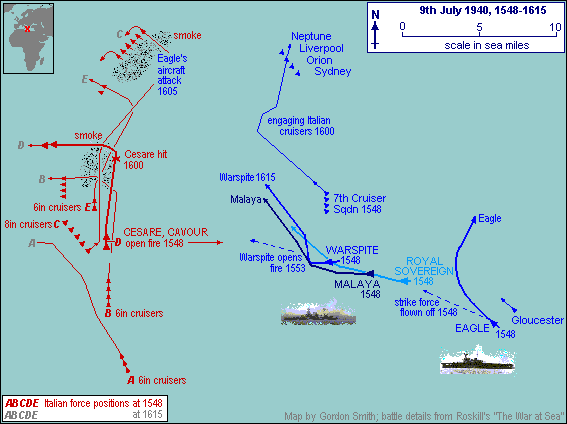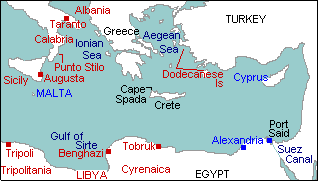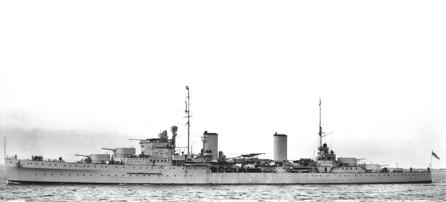Action off
Calabria (see July 1940, Mediterranean)

...1940
JULY 1940
ATLANTIC
- JULY 1940
1st - Corvette
Gladiolus claimed the first success for the
'Flower'
class when with the support of an RAF Sunderland,
she
sank “U-26” southwest of Ireland. 5th -
Detached from a UK outward-bound OB convoy to
search for
a reported U-boat, destroyer
WHIRLWIND
was torpedoed by “U-34”
and lost to the west of Land's End.
French
Navy in the Atlantic - Carrier
Hermes
and cruisers Dorsetshire
and Australian sister-ship Australia
lay off Dakar,
French West Africa on the 8th after negotiations
were
refused on the future of French battleship
“Richelieu”. Attacks made with depth-charges
from a fast motorboat failed and a torpedo strike
by
Swordfish inflicted only minor damage. No action
was
taken against “Richelieu’s” sister ship
“Jean Bart” laying further north at Casablanca,
Morocco. In the French West Indies,
carrier
“Bearn” and two cruisers were immobilised by
mainly diplomatic means. (see also French Navy in
Europe and
Mediterranean below)
German Raiders - Only
11
months before Germany attacked Russia,
“Komet” sailed for the Pacific through the
North East Passage across the top of Siberia with
the aid
of Russian icebreakers. She operated in the
Pacific and
Indian Oceans until returning to Germany in
November
1941, the last of the first wave of surface
raiders to
leave Germany. 28th - Off the coast of
Brazil,
German raider “Thor” badly damaged armed
merchant cruiser “Alcantara” in a gun duel.
Battle
of the Atlantic - Convoys
were now being re-routed through the North Western
Approaches to the British Isles instead of the
south of
Ireland and through the Irish Sea. North Channel
and the
sea lanes leading to it became a focal point for
all
shipping leaving or arriving in British waters.
The
following convoys continued: Liverpool out - OB;
UK/Gibraltar-
OG; Fast Halifax/UK - HX; Gibraltar/UK - HG;
Sierra
Leone/UK - SL. Thames-out
OA convoys were now joining FN East Coast coastal
convoys
and passing around the north of Scotland before
going out
through the North Western Approaches. They stopped
altogether in October 1940. Slow Sydney, Cape
Breton,
Canada to UK convoys started in August 1940 with
SC1. The
limits of the few escorts available were only now
pushed
out from 15°W to 17°W where they stayed until
October
1940. U-boats were patrolling well beyond this
range and
many sinkings took place in unescorted convoys or
when
the ships had dispersed.
Monthly Loss Summary: -
34 British,
Allied and neutral ships of 173,000 tons in the
Atlantic
from all causes; 1 destroyer; - 1 German U-boat.
EUROPE
- JULY 1940
Battle of Britain
-
Hitler decided that an invasion of Britain –
“Operation Sealion” - was possible and ordered
preliminary air attacks starting with English
Channel
shipping and ports. On the 16th, preparations got
underway for landing and assault operations
scheduled to
start in mid-August. On the 19th July Hitler
offered to
make peace with Britain. Three days later his
overtures
were rejected.
French
Navy
in Britain - The
two
World War 1 French battleships "Courbet"
and "Paris" and several destroyers and
submarines, including the giant "Surcouf" were
in British ports. On the 3rd they were boarded and
seized, but not before there were casualties on
both
sides including three British and one French dead.
4th - Anchored
off the SE breakwater within Portland Harbour,
auxiliary AA ship FOYLE
BANK
(Capt H
P Wilson) was
attacked by 33 Ju87 divebombers and hit
by a total of around 22 bombs. With one of the
attackers
shot down, she sank to the bottom with 176 men
killed out
of a total crew of 19 officers and 279 crew.
+ Leading Seaman Jack
Mantle,
gunner in the "Foyle Bank", continued in action
although mortally wounded and was posthumously
awarded
the Victoria
Cross. According to one source she was sunk
off
Portland in attacks on Thames-out convoy 0A178
which also
accounted for four merchantmen. Photographs of her
hit
and sinking confirm the Portland Harbour location.
6th - Home Fleet
submarines carried out patrols off the coast of
southwest
Norway, but with heavy losses in July. Late on the
5th,
SHARK
was badly damaged by German
aircraft and next morning on the 6th had to be
scuttled
off Skudenses. July - A few days later
submarine
SALMON
was presumed lost on mines. Later
still THAMES
was also probably mined in the
middle of the North Sea on passage to her patrol
area.
16th - Cruiser
Glasgow
rammed and sank accompanying
destroyer
IMOGEN
off the Pentland Firth, north of
Scotland.
20th - Heavy
German
attacks continued on shipping and four destroyers
(1-4) were bombed and sunk over the next
few days to add to the losses already sustained.
The
first was
BRAZEN
(1) on convoy duty off Dover. 27th
- Two
more lost to air attack in British waters were
WREN
(2) off Aldeburgh on the English
East
Coast as she gave AA cover to minesweepers, and
CODRINGTON
(3) in Dover harbour. 29th
- The
fourth bombing loss was
DELIGHT
(4)
escorting a Channel
convoy off Portland.
26th - As the
damaged "Gneisenau" made for Germany from
Norway, submarine "Swordfish" carried out an
attack and sank escorting torpedo boat "LUCHS".
Merchant
Shipping War - With
the Germans now so close to British shores, new
coastal
convoy routes had to be established and integrated
with
overseas convoys. The Thames/Forth FN/FS convoys
between
south east England and Scotland continued along
the East
Coast. Two additional routes were instituted:
Forth/Clyde, EN/WN, around the north of Scotland
between
the east and west coasts; and Thames/English
Channel,
CW/CE, through the Strait of Dover to south and
south
west England. Channel losses were so heavy that
CW/CE
convoys were stopped for a while. On the
25th/26th, CW8
lost eight of its 21 ships to attacks by Stukas
and
E-boats. Four more merchantmen and two destroyers
were
damaged
Monthly Loss Summary:
67 British, Allied
and neutral ships of 192,000 tons in UK waters.
MEDITERRANEAN
- JULY 1940
East Africa - Italian
forces
from Ethiopia occupied British border
posts
in Kenya and the Sudan.
French
Navy in the Mediterranean,
3rd, Action at
Oran (Operation 'Catapult') - Adm Somerville
arrived with Force H
off the French Algerian base of Mers-el-Kebir near
Oran.
French Adm Gensoul was offered a number of choices
to
ensure his fleet with its four capital
ships stayed
out of Axis hands. All were turned down and, at
around
18.00, Force H opened fire on the anchored ships.
"BRETAGNE" blew up and the
"Dunkerque" and "Provence", together with other
ships, were badly damaged. Battlecruiser
"Strasbourg" and some destroyers managed to break
out in spite of attacks by aircraft from
Ark
Royal, and reached Toulon in the south of
France.
Three days later the damaged "Dunkerque"
was torpedoed at her
moorings by
Ark Royal's Swordfish. The tragic and unhappy
episode was
over as far as Oran was concerned. 4th - A
more
peaceful solution to the French naval presence was
found
at Alexandria. Adm Cunningham was able to
reach
agreement with Adm Godfrey on the demilitarisation
of
battleship "Lorraine", four cruisers and a
number of smaller ships. No action was taken
against the
French warships at Algiers and Toulon.
For
the Royal Navy an unhappy, but in British eyes,
necessary
duty had been carried out against her former
French ally.
French anger and bitterness was understandably
considerable.
5th -
Obsolescent
torpedo-carrying Swordfish from carrier
"Eagle's"
squadrons flew from land bases on
successful attacks against Tobruk and area. On the
5th,
aircraft of 813 Squadron sank Italian destroyer
"ZEFFIRO" and a freighter at Tobruk. The
success was repeated two weeks later.

9th,
Action off Calabria or
Battle of Punto Stila
(see map
above)
- On the 7th,
Adm Cunningham sailed from Alexandria with
battleships Warspite,
Malaya, Royal
Sovereign, carrier Eagle,
cruisers and
destroyers to cover convoys from Malta to
Alexandria and
to challenge the Italians to action. Next day -
the 8th
- two Italian battleships, 14 cruisers and 32
destroyers were reported in the Ionian Sea
covering a convoy of their own to Benghazi in
Libya. Italian aircraft now started five days of
accurate high-level bombing (also against Force H
out of Gibraltar) and cruiser
Gloucester
was hit and damaged.
Mediterranean Fleet headed for a position to cut
off the
Italians from their base at Taranto. On the 9th,
Eagle's aircraft failed to find the Italians and
first
contact was made by a detached cruiser squadron
which
came under fire from the heavier Italian ships
before it
could return fire itself. "Warspite" came up
and damaged "Giulio Cesare" with a 15in hit. As
the Italian
battleships turned away, the British cruisers and
destroyers engaged, but with little effect.
Mediterranean
Fleet pursued to within 50 miles of the south west
Italian coast off Calabria before withdrawing. As
Adm
Cunningham covered the by now delayed convoys to
Alexandria, "Eagle's" Swordfish attacked
Augusta harbour, Sicily on the 10th.
Destroyer
"Pancaldo" was
torpedoed, but later re-floated and
re-commissioned. 20th
- Carrier "Eagle's" Swordfish continued their
strikes against Italian targets around Tobruk. In
the
nearby Gulf of Bomba, 824 Squadron was responsible
for
sinking destroyers "NEMBO" and "OSTRO" and another
freighter.
 11th
- Force H,
which put to sea on receiving reports of the
Italian
fleet, was now returning to Gibraltar when
screening
destroyer ESCORT
was sunk by Italian submarine
"Marconi".
11th
- Force H,
which put to sea on receiving reports of the
Italian
fleet, was now returning to Gibraltar when
screening
destroyer ESCORT
was sunk by Italian submarine
"Marconi".
16th -
Submarine
PHOENIX
attacked an escorted tanker off
Augusta and was lost to depth charges from Italian
torpedo boat "Albatros".
19th,
Action off Cape Spada - Australian cruiser
Sydney (right
- NavyPhotos/Mark Teadham) and
destroyers "Hasty", "Havock",
"Hero", "Hyperion" and
"llex" on a sweep into the Aegean Sea were sent
to intercept two reported Italian cruisers. Off
Cape
Spada at the north west tip of Crete, "BARTOLOMEO
COLLEONI" was
stopped by "Sydney's" gunfire and finished off
with
torpedoes from the destroyers. "Bande Nere"
managed to escape.
Monthly Loss Summary: 2
British, Allied
and neutral ships of 7,000 tons
STRATEGIC
& MARITIME SITUATION
ATLANTIC
& EUROPE - Britain's
circumstances were transformed. From North Cape
in Norway
to the Pyrenees at the Spanish border, the coast
of
Europe was in German hands. Norwegian bases
threatened
northern Britain. By occupying the Low Countries
of
Holland and Belgium, and northern France, the
south and
east coasts of England were now in the front
line. From
their new French Biscay ports German maritime
forces
dominated the South Western Approaches to the
British
Isles. The British occupation of Iceland took
on a
new and vital importance. The lack of bases in Eire
became
more evident. In addition, the majority of French
possessions
on the Atlantic seaboards of Africa and
the Americas were under the control of Vichy
France, and
thus denied to British forces. Worse still was
the danger
of their occupation by the Axis powers. The naval
situation
was similarly transformed. Not only was
the
French fleet denied to the Allies, but the great
fear was
it would be seized by the German and Italian
navies and
totally alter the naval balance of power. The French
Navy
refused to make for British ports and most
of
the modern ships sailed for French North and
West Africa.
The uncompleted battleships “Jean Bart” and
“Richelieu” reached the Atlantic ports of
Casablanca in Morocco and Dakar in Senegal
respectively.
MEDITERRANEAN
- With the fall of
France, Italy continued to dominate the
central
Mediterranean. The situation in the western
basin became
difficult as shipping between Gibraltar and
Malta could
no longer look to Algeria and Tunis for
protection. At
the eastern end, Lebanon and Syria went over to
Vichy
France and in time endangered Britain's position
in the
Middle East. For now Greece and Crete
remained neutral, otherwise enemy aircraft would
dominate
the Mediterranean Fleet as soon as it left
Egyptian
waters. This happened when they were occupied by
the
Germans. The comparatively healthy naval
position also changed for the worse. In
all except capital ships – seven British to six
Italian - the Royal Navy was distinctly inferior
in numbers to the Italians, but had its two
near-priceless fleet carriers –
Ark
Royal based on Gibraltar, and Eagle,
later joined by Illustrious
operating out of
Alexandria. They came to dominate the
Mediterranean over
the next six months. Fortunately the situation
was also
helped by the French Fleet staying
neutral and out
of Axis hands - that is, until its sovereignty
was under
attack when the French Navy fought back
fiercely. The
arrival of Force H at Gibraltar went
some way to
offsetting the loss of French naval power in the
Western
Mediterranean.
AUGUST
1940
ATLANTIC
- AUGUST 1940
Radar - A
British
scientific mission carried details of many
important
developments to the United States. Amongst these
was the
recently invented cavity magnetron, vital for
short
wavelength radar and the eventual defeat of
conventional
U-boats.
10th - Two more
ex-liners recommissioned as armed merchant
cruisers of
the Northern Patrol were lost to U-boat attack to
the
north of Ireland. "TRANSYLVANIA" was torpedoed and
sunk by
"U-56" on the 10th. 27th/28th - The
second AMC was "DUNVEGAN CASTLE" to "U-46".
20th - Submarine
"Cachalot "on Bay of Biscay patrol sank the
returning "U-51" off Lorient, western France
24th - An
attack by
"U-37" on the first Slow Cape Breton/UK convoy
SC1 to the southeast of Greenland led to the loss
of a
merchantman and sloop "PENZANCE".
Battle
of the Atlantic - Long
range Focke Wulf Kondor bombers started patrols
off the
coast of Ireland from a base near Bordeaux. As
well as
spotting for U-boats they attacked and sank many
ships,
and continued to be a major threat until the
introduction
of ship-borne aircraft in late 1941 started to
counteract
them.
Monthly Loss Summary:
39 British, Allied
and neutral ships of 190,000 tons in the Atlantic
from
all causes, 2 armed merchant cruisers, 1 sloop; 1
German U-boat.
EUROPE
- AUGUST 1940
1st - Submarine
SPEARFISH
on patrol in the North Sea was
torpedoed and sunk by "U-34".
NARWHAL
was paid off the same day. After
leaving the English east coast Humber Estuary on
22nd
July for a minelaying mission off Norway, she
failed to
return.
3rd - Mines laid
off the German North Sea coast by RN destroyers
continued
to claim victims. "U-25" was lost as she headed
out for
Atlantic patrol.
Battle of Britain
-
The Luftwaffe switched its attacks from English
Channel
ports and shipping to RAF Fighter Command and on
the 13th
launched a major offensive - 'Adlertag' -
especially
against airfields. Damage to the airfields and
installations, and losses in aircraft on both
sides were
heavy. Bombs dropped on London on the 24th led to
RAF
Bomber Command raiding Berlin the next night. By
the end
of the month the first possible date for
'Operation
Sealion' had been put back to late September.
Royal Navy Codes - These
were
changed and for the first time operational signals
were secure from German interception and decoding.
It was
another three years before the convoy codes were
made
safe from the German B-Service.
31st/1st September
- Destroyers of the 20th Flotilla sailed to lay
mines off
the Dutch coast, but run into a German field
northwest of
Texel.
ESK
quickly sank,
IVANHOE
went down next day, and
"Express"
was badly damaged.
Eastern Europe - Germany
started
planning the invasion of Russia.
Monthly Loss Summary:
45 British, Allied
and neutral ships of 163,000 tons in UK waters.
MEDITERRANEAN
- AUGUST 1940
1st - Submarine
OSWALD
on patrol south of the Strait of
Messina reported Italian Navy movements. She was
detected
and later rammed and sunk by destroyer
"Vivaldi".
Malta - The
decision was taken to reinforce Malta and in
Operation 'Hurry', carrier "Argus" flew off 12
Hurricanes from a position southwest of Sardinia.
This was the first of many reinforcement and
supply operations, often bitterly fought to keep
Malta alive and in the fight against Axis supply
routes to their armies in North Africa. Now, as in
the future, cover from the west was provided by
Force H. The opportunity was taken for
Ark
Royal's aircraft to hit Sardinian targets.
In the middle of the month, Mediterranean Fleet
battleships Warspite,
Malaya
and
Ramillies
bombarded Italian positions around
Bardia in Libya, just over the border from Egypt.
("The
Supply of Malta 1940-1942", including the
Malta Convoys)
22nd -
Land-based Swordfish from
Eagle's
824 Squadron repeated
their July success with another torpedo strike in
the
Gulf of Bomba near Tobruk. Just as she prepared
for a
human torpedo attack on Alexandria, submarine
"IRIDE" and a depot ship were sunk.
23rd - Heavy
mining
in the Strait of Sicily by Italian surface ships
led to
the loss of destroyer
HOSTILE
on passage from Malta to
Gibraltar. Extensive Italian fields in the
'Sicilian
Narrows' sank and damaged many Royal Navy ships
over the
next three years.
East Africa - Italian
forces
from Ethiopia invaded British Somaliland.
The capital of Berbera was evacuated on the 14th
and the
garrison carried across to Aden. Italians entered
the
town five days later just as a British mission
went into Ethiopia
to help organise uprisings against the Italians.
Monthly Loss Summary: 1
ship of 1,000
tons